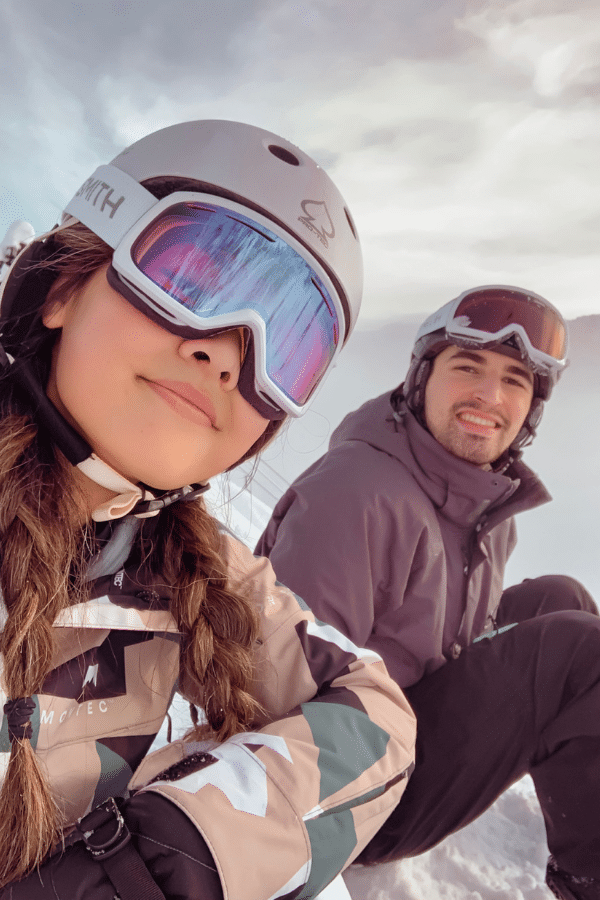How To Plan a Ski Trip with Friends
So, you’re thinking about planning a ski trip with your friends and you need a teensy bit help organizing? Well, you’re in luck since this post is an all-inclusive guide on how to plan a ski trip. It includes everything you need to consider, making the planning process easy and ensuring the trip goes as smoothly as possible.
Coordinating a ski trip is not an easy task. The first time I had to plan a ski trip for my friends, I honestly didn’t know where to start. There were so many things to coordinate, and people had various interests, budgets, and skill levels. I was definitely worried about forgetting something during the planning process!
This post is all about how to plan a ski trip with friends.

THINGS TO CONSIDER BEFORE YOU PLAN
Before diving straight into logistics, you should get a general sense of the following from your friends. All these things will impact the next steps in planning, so having a good idea where everyone stands is the best place to start.
#1: BUDGET
Be mindful of everyone’s expectations for budget. Ski trips are NOT cheap – from lodging and transportation to food and other activities, they can be quite the expense. Sit down and have a conversation about approximately how much everyone is comfortable to spend on this trip. This will help make decision making a bit easier, since you know what constraints to work within.
There are a lot of ways to be more budget friendly on a trip and help meet everyone’s needs. For example, by choosing a lodging option with a kitchen, you can cook more meals at home and cut costs from eating out every meal. Instead of planning a paid activity every night after you ski, you can host a movie and/or board games night.
#2: SKILL LEVEL
It’s important to get a good understanding of everyone’s skill levels because it can influence location, lodging, activities and more! Get a good gauge of how many days everyone would like to spend on the mountain and the types of runs that they’re comfortable doing.
#3 APRES SKI ACTIVITIES
In addition to skiing / snowboarding, figure out what other kinds of activities your group wants to do. Go out to eat? Snowmobile? Zipline? Or nothing at all since long ski days can be exhausting? Knowing what to plan in addition to skiing will help inform picking a location and choosing where to stay.
Alright, now let’s jump into logistics.
Post You Might Like: The Ultimate Ski Trip Packing List
STEPS TO PLAN A SKI TRIP

#1. CHOOSE YOUR SKI TRIP DATES
Choosing dates for your trip might seem easy if it’s based on availability, but there are some factors you’ll want to consider that will affect your experience.
Time of Year & Snow Conditions
The average ski season usually runs from the end of November to early April. If you choose to plan your trip closer to either ends of that date range, snow conditions will be more uncertain. The best way to increase your odds of good ski conditions is to plan something closer to the middle of the season.
However, because the best conditions often are in the middle of the season, December to February are also when the mountains are the most packed. Consider what is more important to you when planning your trip.
Peak Times
Peak times for ski mountains are around the holidays and during weekends. People are off work and school during these times, so the mountain will most likely be crowded. This means longer lines, less runs, and more people to ski into (or who ski into you!). In addition, it can often be more expensive to plan for peak times, unless you plan super early. With higher demand, plane tickets, lodging, and even lift tickets will increase in price. In the past few years, some ski resorts have moved to a dynamic pricing model, where prices fluctuate based on whether the dates are considered “peak” dates.
With all that being said, peak times are peak times because they are simply the easiest times that folks can get up to the mountain. If all your friends work 9-5, Monday through Friday, and it makes sense to go when everyone has a break – aka the holidays or the weekends. Planning to visit at peak times can even be more fun at times, because après ski is livelier.
If you’re choosing to go at a peak time, the best advice is to just plan as far in advance as you can. As you know, the closer you get to the dates, the more expensive everything will be.
#2. PICK YOUR SKI TRIP LOCATION
Know exactly where you want to go? Great, skip ahead! Not sure? Then this section is for you.
There are so many factors to take into consideration when choosing a ski destination – both on and off the mountain. Each ski resort has its own highlights, so take some time to decide which destination would be best fit for your trip. Here is a fantastic article that lists ski resorts around the US, based on what you’re looking for.
When choosing your location, these are four important factors that you’ll want to consider:
Trails & Skill Levels
Make sure to look at the mountain’s trail map and see if the runs align with the skill levels of everyone in the group. If there are beginners, check for an adequate number of green runs so they can continue to hone their skills. More advanced skiers and snowboards might be itching for challenging black runs.
Distance from Lodging & Activities
Some ski mountains have base villages that surround its slopes, offering visitors lots of ease transitioning from the ski day to other activities. If there’s a broad range of skill levels in your group, opt for a ski resort that has a base village. This will provide more flexibility to accommodate everyone’s preferences, since you can leave the mountain at any time and find things to do nearby. This is especially optimal if you don’t have a car since food and shopping areas should be walkable from the mountain.
If activities around the mountain don’t really matter to you, you can always choose a destination that does not have a base village and stay in the nearest town. However, since you’re no longer walking distance from the ski lifts, you’ll need to plan for transportation to and from the mountain for each ski day.
Travel Time to the Mountain
Ski resorts are usually far from most cities, so take into consideration the total travel time before settling on a location. In addition to this, decide how you’ll get there. If you have access to a car, great! If not, you can either rent one or look for shuttles that will take you to your destination.
Food & Activities Nearby
When choosing your location, take into account what there is to do nearby outside of skiing. Make a note of any restaurant reservations or activities you need to book ahead of time. Here’s a quick list of activities ideas to think through!
Fun in the Snow:
- Snowmobiling
- Sledding or Tubing
- Snowshoeing
- Cross-country skiing
Things to Do in Town:
- Going to the spa
- Shopping
- Barhopping
- Going out to eat
#3. FIND LODGING
Depending on which ski destination you’ve chosen, you’ll have quite a few different options for lodging. The two factors you’ll want to consider are the type of accommodation and the location.
Here’s a quick an article on the different types of ski accommodations that showcases pros and cons to each. A few things to consider are:
- How much time will you be spending there?
- Will you be cooking there and want a kitchen area?
- What other activities do you want to be able to do? Ie. go to the pool
Deciding the location will be a function of cost and convenience. Often, the two go together – the closer you stay to the slopes, the higher the cost. Some accommodations offer ‘ski in ski out,’ meaning you will have access to ski trails right outside your door. These can be pricey, but definitely make for a smooth transition in and out of your ski day!
#4. DECIDE ON GEAR
What you need to decide for gear is whether you’ll be renting or not. Most, if not all, ski mountains have a gear rental shop. You can also rent gear from a local sporting goods shop. As a skier, you’ll need skis with bindings, boots, and poles. As a snowboarder, you’ll need the snowboard with bindings and boots.
To help guide your decision, here are some details between renting and bringing your own gear to consider:
You should rent if you…
- Want convenience: You won’t need to transport it to and from the mountain (which can be an even bigger hassle if you’re going on a plane and need to check your bag).
- Don’t have your own gear yet: Renting is usually more budget friendly than purchasing all new gear.
- Want to try before you commit: If it’s your first few times skiing, renting will let you try it out before investing money into ski gear. You can also try out different types of skis and boards and decide what you like.
- Don’t mind potentially waiting in long rental lines: This is if you decide to rent at the ski mountain. If you choose to rent at a local sporting goods shop, there usually isn’t too much of a wait time.
- Are comfortable with paying around $25-$100 per a day to rent on the mountain.
You should bring your own gear if you…
- Already have your own gear and love skiing / snowboarding with it
- Don’t mind the cost of transporting it: If you’re traveling to your destination by plane, you’ll have to consider the fees to check your gear.
- Have a convenient way to transport your gear
- Don’t want to pay to rent
And that’s it! These four steps are the main components of logistics you’ll need to plan for. This posts was all about how to plan a ski trip.
